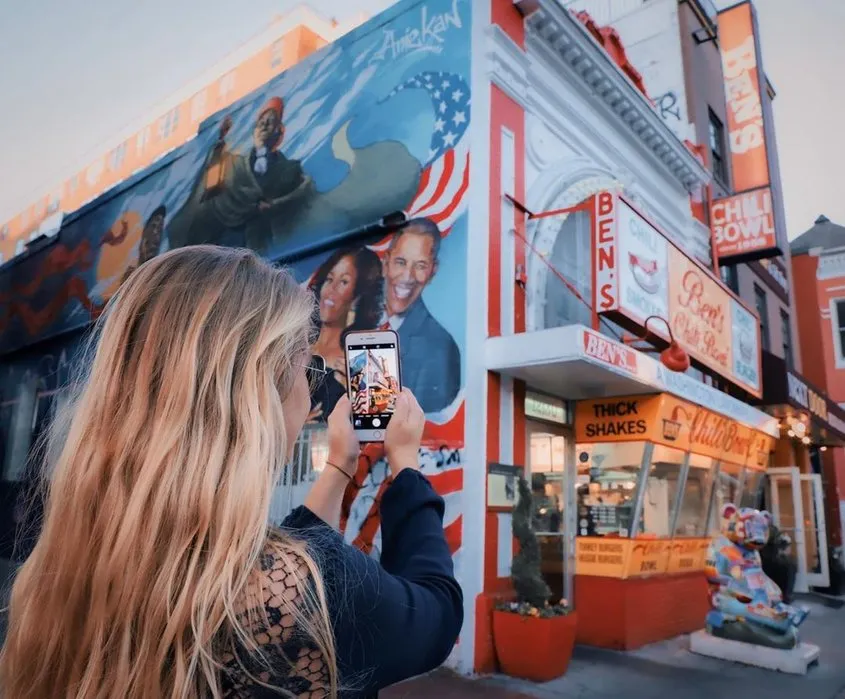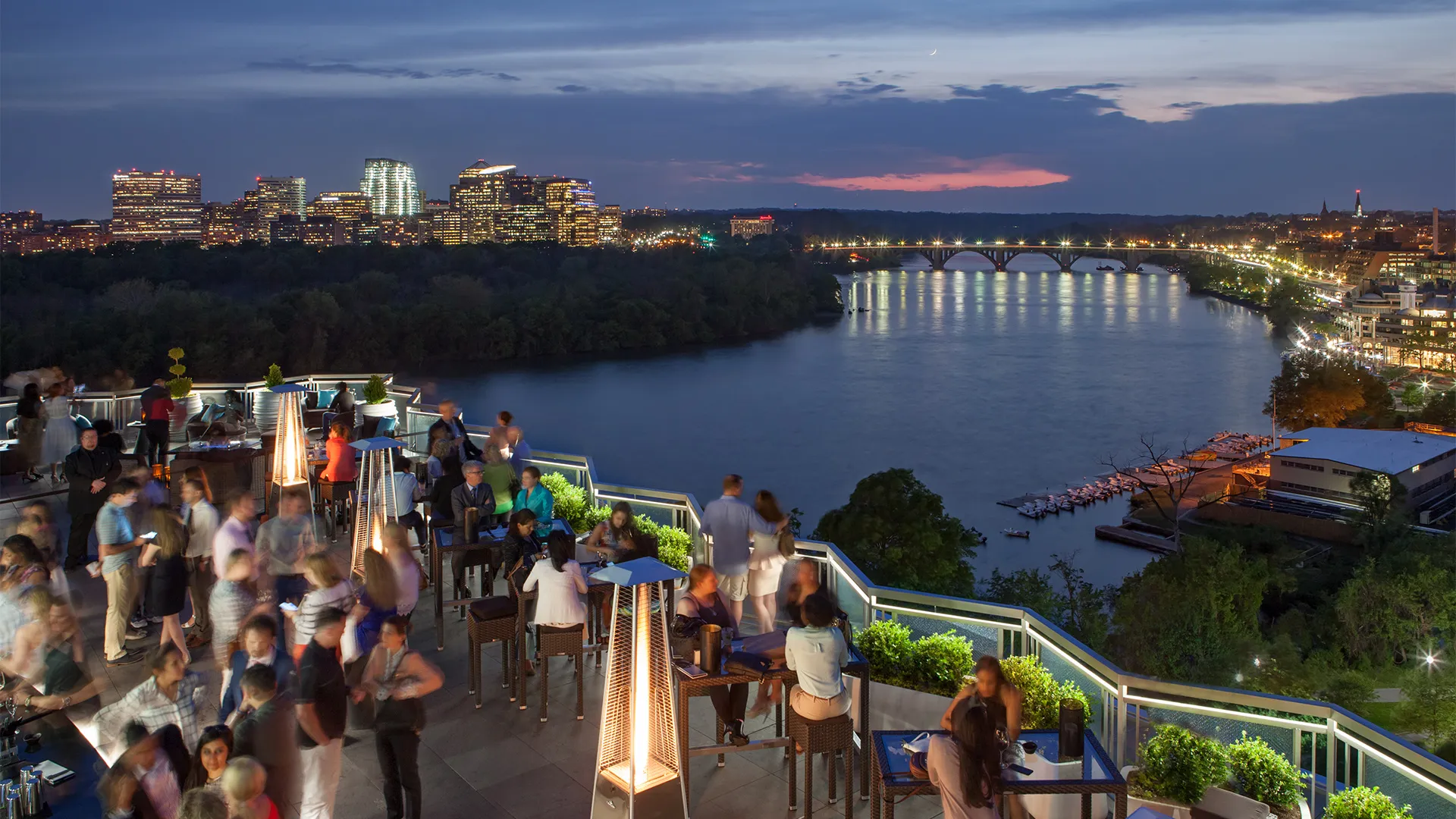Washington D.C., the dazzling capital of the United States, is not just a political hub but also a rich repository of culture and history. Beneath the modern veneer of a bustling metropolis, D.C. hides ancient streets that preserve the imprint of time and captivating stories of the past. Join Discovery To Wonders as we explore the oldest historic streets in Washington, where every step is a journey back in time, touching the heart of America.
Georgetown: The Oldest Neighborhood and Cobblestone Paths
Georgetown, Washington D.C.’s oldest neighborhood, feels like a living outdoor museum where time seems to slow down. Winding cobblestone streets, charming brick townhouses, and shady old trees create an atmosphere that is both historic and serene. Georgetown is more than just a neighborhood; it’s a historical witness that has seen the formation and development of the nation’s capital.
A special highlight of Georgetown is the Chesapeake and Ohio (C&O) Canal, a historic waterway transportation project dating back to the 19th century. Along the canal banks, visitors can stroll under cool green trees, watch sailboats dock, and feel the peaceful, quiet atmosphere. The C&O Canal is not only a historical monument but also a symbol of the connection between past and present, between nature and the city.
Nestled in the heart of historic Georgetown is the Old Stone House, the oldest surviving building in Washington D.C., built in 1765. Stepping through the time-worn wooden door, visitors enter another world where stone walls tell the story of American life in the past. The Old Stone House is not just an architectural structure but also a miniature museum preserving invaluable cultural and historical values.
Georgetown is also home to Georgetown University, one of the most prestigious and oldest universities in the United States. The sprawling campus with its ancient buildings featuring Gothic architecture creates a solemn and venerable academic space. Georgetown University is not only an educational center but also an integral part of Georgetown’s cultural and historical heritage.
To fully explore the beauty and history of Georgetown, visitors should take time to wander charming little streets like M Street and Wisconsin Avenue, home to high-end fashion boutiques, unique art galleries, and elegant restaurants. Don’t forget to visit Book Hill, an area famous for its antique bookstores, delicious pastry shops, and vintage clothing stores. Georgetown is not just a tourist destination, but a cultural experience where visitors can discover new things and enjoy memorable moments.

Capitol Hill: The Center of Power and Tree-Lined Streets
Capitol Hill, the historic hill where the United States Capitol stands, is not only a symbol of American power but also a charming neighborhood with tree-lined streets and beautiful rows of townhouses. Stepping onto Capitol Hill, visitors will sense the solemnity and majesty of the political buildings while immersing themselves in the cool, green, peaceful space of the old streets.
The most prominent architectural highlight of Capitol Hill is the United States Capitol, the magnificent Congress building with its massive dome and pristine white marble columns. The Capitol is not only the workplace of the U.S. Congress but also a symbol of democracy and state power. Visitors can take guided tours to explore the splendid interior of the Capitol and learn about its history and architecture.
Opposite the Capitol lies the Library of Congress, an invaluable treasure trove of human knowledge. The Library of Congress is not just a library, but also a museum, a research center, and a cultural icon of the United States. Visitors can admire the unique architecture of the Library of Congress, explore its vast collection of books, manuscripts, and documents, and participate in exhibitions and cultural events held there.
Capitol Hill is also famous for Barracks Row, one of the oldest commercial streets in Washington D.C. Barracks Row was once the station for the United States Marine Corps in the early 19th century, and today it has become a bustling street with many restaurants, bars, and unique shops. Visitors can enjoy diverse cuisine at the restaurants on Barracks Row, shop for souvenirs and handicrafts at local stores, or simply stroll and admire the historic townhouses.
To experience the green space of Capitol Hill, visitors should visit the United States Botanic Garden, a natural oasis in the heart of the capital. The U.S. Botanic Garden displays thousands of plant species from around the world, arranged in themed gardens and magnificent glass conservatories. Visitors can relax in the garden’s cool green space, discover the diversity of the plant world, and learn about the importance of nature conservation.

Dupont Circle: Historic Roundabout and Grand Mansions
Dupont Circle, Washington D.C.’s famous traffic circle, is not only a major transportation hub but also a historic neighborhood featuring grand mansions, elegant embassies, and unique cultural and artistic spaces. Dupont Circle possesses a refined, sophisticated beauty and a touch of mystery, attracting visitors with its harmonious blend of history, culture, and modern lifestyle.
The center of Dupont Circle is Dupont Circle Park, a circular green space highlighted by the Bartholdi Fountain. Dupont Circle Park is a frequent spot for locals and tourists to relax, stroll, read, or simply watch the vibrant city life. On Sundays, Dupont Circle Park hosts the Dupont Circle Farmers Market, selling fresh produce, unique handicrafts, and delicious street food.
Surrounding Dupont Circle Park are historic mansions built in the late 19th and early 20th centuries, featuring Beaux-Arts and Queen Anne architectural styles. Many of these mansions now house embassies, international organizations, and art museums. Visitors can admire the architectural beauty of these mansions, learn about the history and culture of countries around the world, or visit The Phillips Collection, America’s first museum of modern art, located in a historic mansion on 21st Street.
Dupont Circle is also a vibrant cultural and arts center in Washington D.C., with numerous art galleries, theaters, and live music clubs. Visitors can explore contemporary artworks at galleries on Connecticut Avenue, enjoy jazz and blues performances at legendary clubs, or watch a play at one of the neighborhood’s renowned theaters.
To experience international cuisine in Dupont Circle, visitors should explore the diverse restaurants and eateries along Connecticut Avenue and Massachusetts Avenue. Dupont Circle is a convergence point for many global culinary cultures, from refined French cuisine and romantic Italian dining to unique Ethiopian dishes and flavorful Latin American tastes.

U Street: Jazz Corridor and Cultural Heritage
U Street, also known as the U Street Corridor, is the heart and soul of Washington D.C.’s jazz scene and the cultural heritage of its African American community. This neighborhood was once the entertainment and cultural center for Black residents during the era of segregation and produced many famous artists, writers, and activists, including the legendary jazz musician Duke Ellington. U Street is not just a neighborhood, but a symbol of the struggle for equality and freedom, a place preserving invaluable cultural and historical values.
An unmissable destination on U Street is the Howard Theatre, an icon of jazz music and African American culture. The Howard Theatre once hosted performances by legendary artists like Duke Ellington, Ella Fitzgerald, and Billie Holiday. Today, the Howard Theatre continues to be a popular live music venue, attracting tourists and locals who love music and culture.
To learn about the history and heritage of the African American community during the U.S. Civil War, visitors should visit the African American Civil War Memorial and Museum. The memorial is an impressive architectural structure honoring the Black soldiers who fought for the Union during the Civil War. The museum displays artifacts, documents, and stories about the role of African Americans in the war.
U Street is also famous for its vibrant bar and nightclub scene, especially along the adjacent 14th Street Corridor. Visitors can enjoy live music, sip craft cocktails, and immerse themselves in Washington’s bustling nightlife. This area also boasts numerous restaurants and eateries serving diverse cuisine, from traditional Ethiopian food to modern fusion dishes.
To discover street art on U Street, visitors should wander through the alleys and side streets, where colorful murals tell stories about the history, culture, and people of the neighborhood. Street art on U Street is not just decoration, but a form of cultural and social expression, a way for the community to share its voice and vision.

Conclusion
The oldest historic streets in Washington D.C. are more than just thoroughfares; they are the cultural and historical lifelines of the nation’s capital. Each street carries its own story, unique beauty, and distinct historical and cultural value. Take the time to explore these streets to better understand the past, present, and future of Washington D.C., and to deeply appreciate the diverse and rich tapestry of American culture. Discovery To Wonders hopes this article serves as inspiration and useful information for your journey exploring Washington D.C.